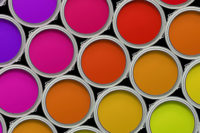Researchers Develop Novel Procedure for Obtaining Natural Nanopigments

ALICANTE, Spain — The University of Alicante Research Group in Vision and Color has developed a novel procedure for obtaining natural hybrid nanopigments able to optimize the optical, thermal and mechanical properties of the composite materials they are applied to. These new nanopigments allow full control of properties such as the amount of dye adsorbed, the degradation temperature of the dye or final composite material, flexural strength, resistance to UV degradation, and transparency or color strength, among others.
To that end, the experts employ nanoclays that are completely natural, harmless to humans, and obtained from minerals, such as montmorillonite, for cosmetics, or hydrotalcite, employed in drugs as a stomach acid scavenger. “Depending on the property of the material to be enhanced, the most suitable nanoclays and additives are selected for synthesis, as well as the order in which they are added,” UA researchers Bàrbara Micó and Francisco M. Martínez-Verdú explained.
The patented innovation makes it possible to obtain materials with advanced properties and a high resistance to physical agents such as solar radiation, temperature or rubbing in clothes. It also reduces costs, as it is a synthesis process conducted at room temperature with basically two ingredients, a dye and a nanoclay, which are both natural.
In this regard, the nanopigments obtained are able to increase the optical, thermal and mechanical resistance of many products, including printing inks, paints, coloring of functional bioplastics using 3D printing for car interiors, synthetic or natural fibers, ceramics, paper, toys, footwear, cosmetics or food packages, as well as in materials employed in the construction, textile, wood, furniture, stone or marble industries.
“With these nanopigments, for instance, the color of furniture or construction materials becomes more resistant in outdoor areas directly exposed to natural light,” Micó explained. In cosmetics like make-up or lipstick, “It is possible to achieve greater durability and a broader range of colors if mixed with other pigments,” said Martínez-Verdú.
Looking for a reprint of this article?
From high-res PDFs to custom plaques, order your copy today!







